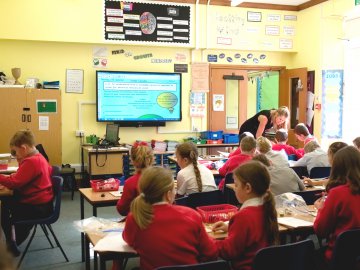Who went into teaching to spend their time delving through IT acronyms and broadband infrastructure? Not many of you I’m sure. Putting together the first “connectivity" article, I realised just how easy it is to take for granted the abbreviations I have come to use every day.
The digital world: why should I care?
The growth of the digital world has been exponential, and there’s no getting away from it. Younger generations have grown up with it, from hand held devices, to live streaming television and online gaming. It affects everything we do, and we are really beginning to see the impact now. From the growing concern over the effect on Mental Health, the rise of cyber bullying, and use in radicalisation, the internet can and does also provide a world of opportunities.
With over half the world’s population online (a growth rate of 764% over 15 years) it’s vital we all have access to it, and we learn how to use it properly. In Europe alone more than 75% of the population has “gone digital”. Whilst on average we spend 1,900 minutes a month online. There’s been lots of talk lately about whether we should accept superfast broadband being sold as an “up to Service”. But should in fact we just be grateful we can get it?!
When you are faced with changing suppliers or choosing connectivity options, not only do you have to compare companies and what they offer; from safety and security, to filtering and monitoring policies, but also things like their compliance with DPA and GDPR. And all of this is just the tip of the iceberg; what about adhering to the latest Ofsted and DfE requirements? And that’s before we even dip our toe into the plethora of technical jargon.
There are so many types of broadband, but really we are all just after something that works, which we can afford
Do we need to know what it all means?
Yes! Well...sometimes!
In order to be an informed purchaser, you need to know what you can get and what you are looking to purchase is capable of delivering.
When ordering your chosen solution you need to understand its capabilities and limitations in order to make it work for you, and ensure there are no hidden charges, or artificial caps. Understanding which connection is right for your school is based on a number of different factors, and not just how many pupils you have:
- The number of learners
- The number of devices
- Your wireless infrastructure
- Servers
- Cloud hosted programs
These are just some of the factors to look at when considering what type of connectivity is right for you. That’s before looking at delivery of ICT in the classroom itself! All too often though, the deciding factor will be budget vs availability, so let’s look at the options.
The need for speed
In the previous article we covered Fibre to the Cabinet (FttC) and how this service can vary dramatically for individual consumers. ADSL and FttC services are delivered over PSTN (Public Switched Telephone Network) lines. That’s a phone line to you and me, and is actually copper pairing. It is the quality, length, and age of this line that will determine the speed of your broadband, which is why they are sold as “up to” services.
It is the quality, length, and age of this line that will determine the speed of your broadband, which is why they are sold as 'up to' services.
There is a variant to FttC called EoFttC/EoSFBB; Ethernet over superfast broadband. This service is almost identical to FTTC, but there are more stringent SLAs in place and the speeds are offered with symmetrical guarantees. Essentially it utilises the same technology back to the exchange but the data traffic has “Ethernet prioritisation”.
Thankfully most of us have been able to move away from ADSL (Asymmetric Digital Subscriber Line). ADSL connects to the exchange using copper lines. The further the distance, the more impacted the service. Whilst there are variations to ADSL, the important thing to remember is that at its very best you might get download speeds of 20Mb, but at its worse, less than 1MB. The upstream will never peak above 2Mb. For some schools, there is often no choice but to survive on ADSL services. This problem commonly affects rural primaries, though not always.
Sometimes premises (and yes, frequently schools) are connected directly to an Exchange; often referred to as EO (exchange only) lines. Unfortunately Superfast broadband cannot be delivered over this type of line. There are options to explore if you are in this situation, but there is no quick fix I’m afraid.
But don’t be confused, fibre broadband is very different to leased line fibre. Leased line is a fibre optic network connection, which connects a premise directly to an exchange. Leased lines are capable of speeds up to 10Gbps and you buy a speed that is suitable for you, 50Mb, 100Mb, or 200Mb. A good leased line service won't be contended, which means it isn’t shared with anyone else. This means you get what you pay for, its expensive, high quality and scalable.
What is a school to do?!
We might have come a long way from old legacy technology, but with such rapid advancements in the digital world, is our broadband keeping up? With so much data and reliance on the cloud, and developments in technology, running a home, school or business on ADSL is a frustration and uphill challenge. But fibre is almost always too expensive for primaries and that was before these times of austerity.
The digital horizon
So what’s next? In some places “superfast broadband” is already outdated. Whilst BT may still be upgrading some cabinets to superfast broadband, others are benefiting from “ultra-fast” broadband, FttP (Fibre to the Premise), or G.Fast.
FttP it being heralded as the next “ultrafast” broadband solution, as we digitally surpass the capabilities of superfast broadband. Our next instalment will look at how FttP differs, why it’s going to be bigger and better, and when you might be able to benefit from it.






